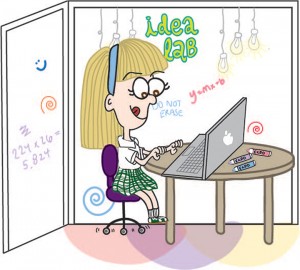The structure of where you learn provides structure for how you learn
For many of the Hockaday seniors, the year 1997 is at best an abstract concept. Many, however, are aware of and use classrooms in the LLARC or in the main building, both of which were either designed or redesigned by Good Fulton & Farrell Architects, a Dallas architectural firm that started working with Hockaday on these projects in 1997.
Though often overlooked, architecture can significantly affect academic learning and performance. According to a 2012 study done by the University of Salford in the U.K., the physical environment and design of a classroom can affect a student’s academic progress over a year by up to 25 percent.
Associate Principal of Good Fulton & Farrell David Dumas fully believes in the effect of architecture on academics. “We always look at how to make learning spaces more interactive for the student, more conducive for learning, more flexible and basically more exciting,” Dumas said.
Some of the features of the new science building designed with this objective in mind include sound insulating on the walls to allow students to concentrate, the sundolier feature and the IDEA labs.
“[The IDEA lab] is a non-traditional space that allows students to do things they’ve never done before,” Dumas said. He emphasized that the IDEA labs have a movable partition that can make it larger or smaller, which again helps add more flexible space for Hockaday students.

Another space created to foster student excellence is the engineering lab and shop, which is used by the Junior Engineering and Technical Society, a group that participates in yearly robotics competitions.
“Before, JETS was in a very small room, and it was hard to actually have an engineering class because you didn’t have the space,” Dumas said. “Now, we have the space for both the design and the learning part.”
Junior Gillian Meyer, who leads JETS, agrees that the expansion of space has benefitted the team.
“In both the old building and in the portable, we had issues finding space to fit our machinery along with our projects. The new engineering space inspires a greater sense of creativity,” Meyer said. “The abundance of brainstorming spaces encourages us to constantly be thinking of new ideas.”
JETS also now uses many new technologies, such as 3-D printers and laser cutters, installed within the engineering lab to support their activities. “The laser cutter is amazing and most definitely would not have fit in either of our old spaces,” Meyer said. “We are hoping to use the laser cutter to cut more precise gears and wheels in the future.”
Some believe that Hockaday students would be equally successful regardless of their environment and facilities. Based on her experience, Director of College Counseling Carol Wasden thinks so.
“[Hockaday students] are such talented students, truly. I think we could put [Hockaday] girls anywhere; we could put [them] on a bus, in portable classrooms, and [they] would still do very well,” Wasden said.
Meyer, however, still feels the science building has improved her overall learning experience, even outside of JETS.
“The overall openness of the new science building makes the classrooms seem less claustrophobic,” Meyer said. “As counterintuitive as it seems, it is honestly amazing what a few windows can do for one’s ability to focus in class.”
Jenny Zhu – Assistant Web Editor


